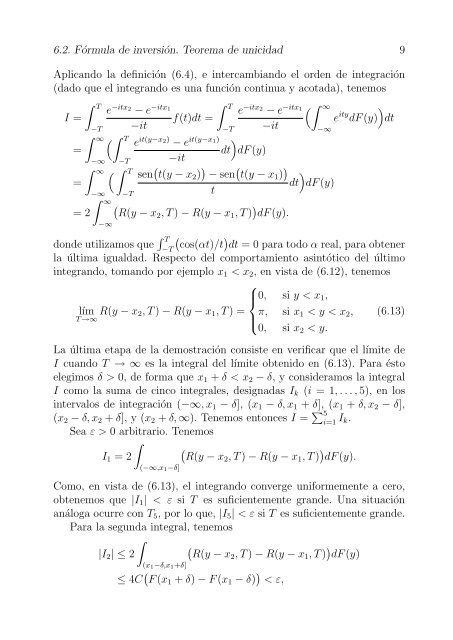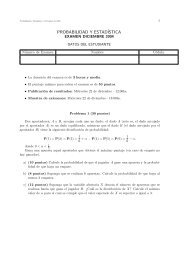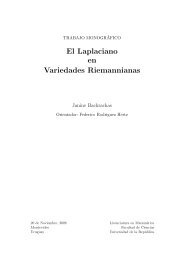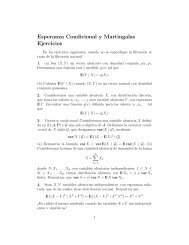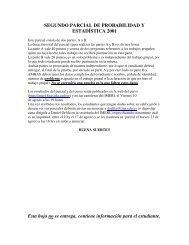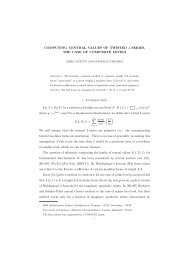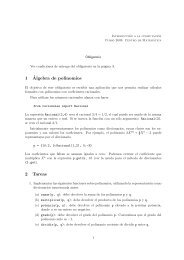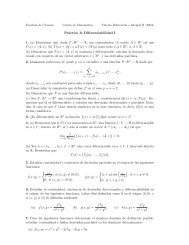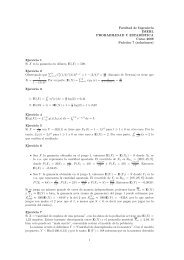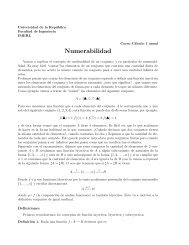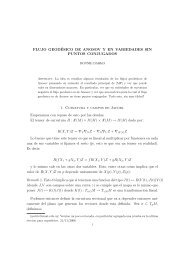CapÃtulos 6 y 7 de Petrov. V.V, Mordecki, E. TeorÃa de la ...
CapÃtulos 6 y 7 de Petrov. V.V, Mordecki, E. TeorÃa de la ...
CapÃtulos 6 y 7 de Petrov. V.V, Mordecki, E. TeorÃa de la ...
You also want an ePaper? Increase the reach of your titles
YUMPU automatically turns print PDFs into web optimized ePapers that Google loves.
6.2. Fórmu<strong>la</strong> <strong>de</strong> inversión. Teorema <strong>de</strong> unicidad 9Aplicando <strong>la</strong> <strong>de</strong>finición (6.4), e intercambiando el or<strong>de</strong>n <strong>de</strong> integración(dado que el integrando es una función continua y acotada), tenemosI ==== 2∫ T−T∫ ∞−∞∫ ∞−∞∫ ∞−Tt∫ Te −itx 2− e −itx 1e −itx 2− e −itx 1 ( ∫ ∞f(t)dt =−it−T −it−∞( ∫ Te it(y−x2) − e it(y−x 1) )dt dF (y)−T −it( ∫ Tsen ( t(y − x 2 ) ) − sen ( t(y − x 1 ) ) )dt dF (y)−∞(R(y − x2 , T ) − R(y − x 1 , T ) ) dF (y).)e ity dF (y) dtdon<strong>de</strong> utilizamos que ∫ T( )−T cos(αt)/t dt = 0 para todo α real, para obtener<strong>la</strong> última igualdad. Respecto <strong>de</strong>l comportamiento asintótico <strong>de</strong>l últimointegrando, tomando por ejemplo x 1 < x 2 , en vista <strong>de</strong> (6.12), tenemos⎧⎪⎨ 0, si y < x 1 ,lím R(y − x 2, T ) − R(y − x 1 , T ) = π, si x 1 < y < x 2 , (6.13)T →∞ ⎪⎩0, si x 2 < y.La última etapa <strong>de</strong> <strong>la</strong> <strong>de</strong>mostración consiste en verificar que el límite <strong>de</strong>I cuando T → ∞ es <strong>la</strong> integral <strong>de</strong>l límite obtenido en (6.13). Para éstoelegimos δ > 0, <strong>de</strong> forma que x 1 + δ < x 2 − δ, y consi<strong>de</strong>ramos <strong>la</strong> integralI como <strong>la</strong> suma <strong>de</strong> cinco integrales, <strong>de</strong>signadas I k (i = 1, . . . , 5), en losintervalos <strong>de</strong> integración (−∞, x 1 − δ], (x 1 − δ, x 1 + δ], (x 1 + δ, x 2 − δ],(x 2 − δ, x 2 + δ], y (x 2 + δ, ∞). Tenemos entonces I = ∑ 5i=1 I k.Sea ε > 0 arbitrario. Tenemos∫(I 1 = 2 R(y − x2 , T ) − R(y − x 1 , T ) ) dF (y).(−∞,x 1 −δ]Como, en vista <strong>de</strong> (6.13), el integrando converge uniformemente a cero,obtenemos que |I 1 | < ε si T es suficientemente gran<strong>de</strong>. Una situaciónanáloga ocurre con T 5 , por lo que, |I 5 | < ε si T es suficientemente gran<strong>de</strong>.Para <strong>la</strong> segunda integral, tenemos∫(|I 2 | ≤ 2R(y − x2 , T ) − R(y − x 1 , T ) ) dF (y)(x 1 −δ,x 1 +δ]≤ 4C ( F (x 1 + δ) − F (x 1 − δ) ) < ε,


